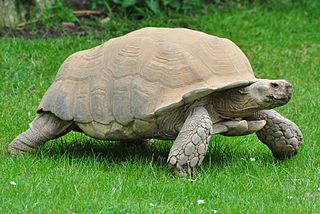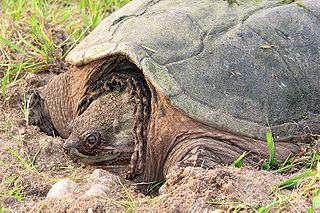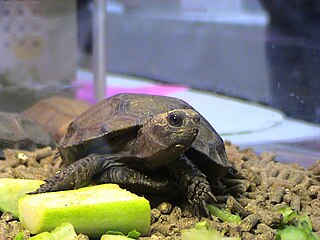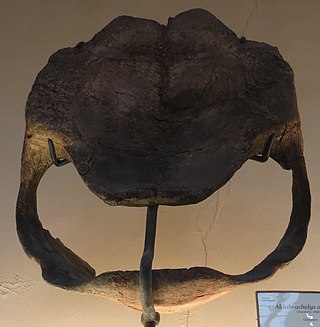
Tortoises are reptiles of the family Testudinidae of the order Testudines. Like other turtles, tortoises have a shell to protect from predation and other threats. The shell in tortoises is generally hard, and like other members of the suborder Cryptodira, they retract their necks and heads directly backward into the shell to protect them.

The African spurred tortoise, also called the sulcata tortoise, is an endangered species of tortoise inhabiting the southern edge of the Sahara Desert, the Sahel, in Africa. It is the largest mainland species of tortoise in Africa, and the third-largest in the world, after the Galapagos tortoise and Aldabra giant tortoise. It is the only living species in its genus, Centrochelys.

The leopard tortoise is a large and attractively marked tortoise found in the savannas of eastern and southern Africa, from Sudan to the southern Cape Province. It is the only extant member of the genus Stigmochelys, although in the past, it was commonly placed in Geochelone. This tortoise is a grazing species that favors semiarid, thorny to grassland habitats. In both very hot and very cold weather, it may dwell in abandoned fox, jackal, or aardvark burrows. The leopard tortoise does not dig other than to make nests in which to lay eggs. Given its propensity for grassland habitats, it grazes extensively upon mixed grasses. It also favors succulents and thistles.

Chelydra is one of the two extant genera of the snapping turtle family, Chelydridae, the other being Macrochelys, the much larger alligator snapping turtle. The snapping turtles are native to the Americas, with Chelydra having three species, one in North America and two in Central America, one of which is also found in northwestern South America.

Manouria is a genus of tortoises in the family Testudinidae. The genus was erected by John Edward Gray in 1854.

Hesperotestudo is an extinct genus of tortoise native to North and Central America from the Early Miocene to the Late Pleistocene. Species of Hesperotestudo varied widely in size, with a large undescribed specimen from the Late Pleistocene of El Salvador reaching 150 cm (4.9 ft) in carapace length, larger than that of extant giant tortoises. Historically considered a subgenus of Geochelone, it is now considered to be distantly related to that genus. Its relationships with other tortoises are uncertain. The exposed areas of the bodies of Hesperotestudo species were extensively covered with large dermal ossicles, which in life were covered in keratin. It has been suggested that species of Hesperotestudo were relatively tolerant of cold weather. Hesperotestudo became extinct at the end of the Pleistocene roughly co-incident with the arrival of the first humans in North America. There is apparently a site in Florida where one individual may have been killed that some suggested were evidence of butchering, although others suggested that the turtle was neither cooked nor does a ledge that was found near it date at the same time as it.

Chelonoidis is a genus of turtles in the tortoise family erected by Leopold Fitzinger in 1835. They are found in South America and the Galápagos Islands, and formerly had a wide distribution in the West Indies.

Stigmochelys is a genus of tortoise endemic to Africa. Stigmochelys pardalis, the leopard tortoise, is the only extant species. A fossil species, Stigmochelys brachygularis is known from the Pliocene of Tanzania. Leopard tortoises were once placed in the genus Geochelone along with many other large tortoises.

Aldabrachelys abrupta, the abrupt giant tortoise, is an extinct species of giant tortoise that was endemic to Madagascar.

Megalochelys is an extinct genus of tortoises that lived from the Miocene to Pleistocene. They are noted for their giant size, the largest known for any tortoise, with a maximum carapace length of over 2 m (6.5 ft) in M. atlas. The genus ranged from western India and Pakistan to as far east as Sulawesi and Timor in Indonesia, though the island specimens likely represent distinct species.
Centrochelys atlantica is a putative extinct species of tortoise supposed to have lived in the Pleistocene recorded in the volcanic crater on Sal, Cape Verde. Tortoise fossils were described but not named from the crater in 1935. Four further bones from a private collector supposed to have been found in the same crater were described in 1998 as a new species similar to the extant Testudo calcarata, differentiated from C. sulcata by its smaller size and lesser robusticity.

The Tenerife giant tortoise is an extinct species of cryptodire turtle in the family Testudinidae endemic to the island of Tenerife, in the Canary Islands during the Middle Pleistocene.
The Gran Canaria giant tortoise is an extinct species of cryptodire turtle in the family Testudinidae endemic to the island of Gran Canaria, in the Canary Islands.

Scott A. Thomson is an Australian herpetologist, paleontologist, and taxonomist, specialising in turtles of the family Chelidae.
Phrynops paranaensis is an extinct species of turtle in the family Chelidae. This fossil species is from the Huayquerian Ituzaingó Formation of the Paraná Basin, Argentina, likely to be late Miocene in origin.

Titanochelon is an extinct genus of giant tortoises known from the Early Miocene to the beginning of the Pleistocene in Europe, extending from the Iberian Peninsula to Anatolia. Some members of the genus were larger than extant giant tortoises, with a shell length of up to 2 m.
Chelonoidis alburyorum is an extinct species of giant tortoise that lived in the Lucayan Archipelago from the Late Pleistocene to around 1400 CE. The species was discovered and described by Richard Franz and Shelley E. Franz, the findings being published in 2009.

Solitudo is an extinct genus of tortoise that was found during the Pliocene and Pleistocene on the Mediterranean islands of Menorca, Malta and Sicily. The genus includes three described species, Solitudo robusta, Solitudo gymnesica and Solitudo sicula as well as a likely fourth, undescribed species from Monte Pellegrino in Sicily. Solitudo sicula, the youngest of the species, died out approximately 12.5 thousand years BP. The largest species, Solitudo gymnesica, has been estimated to have reached a carapace length of 1.1–1.3 m (3.6–4.3 ft).
Chelonoidis cubensis, also known as the Cuban giant tortoise, is an extinct species of land tortoise that lived in Cuba from the Late Pleistocene to the Early Holocene. It had a carapace length of between 40 cm and 90 cm. It is thought that the species went extinct through human exploitation.
Chelonoidis monensis, also known as the Mona tortoise, is an extinct species of land tortoise that lived on the island of Mona from the Late Pleistocene to around 1000 BCE. Evidence for the latter date includes cave drawings. All fossil remains have been found either in or near Liro Cave on the east side of Mona. It had a carapace length of around 50 cm (20 in).















